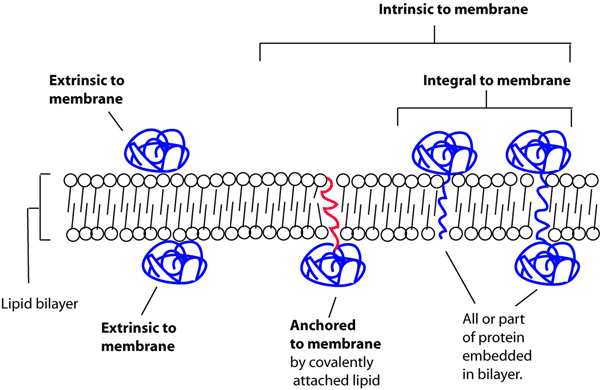Membrane Proteins
Membrane Proteins
As GO cellular component terms describe locations where a gene product may act, rather than physical features of proteins or RNAs, the terms integral membrane protein and peripheral membrane protein are present only as non-exact synonyms.
GO distinguishes classes of membrane-related location:
extrinsic to membrane ; GO:0019898 refers to gene products that are associated with membranes, but are neither directly embedded in the membrane nor anchored by covalent bonds to any moiety embedded in the membrane.
intrinsic to membrane ; GO:0031224 refers to gene products that have some covalently attached moiety embedded in the membrane, and is further split into integral to membrane ; GO:0016021 and anchored to membrane ; GO:0031225. The former refers to proteins in which some part of the peptide sequence spans all or part of the membrane (in theory, it could also be used for RNAs embedded in a membrane, if any such exist); the latter refers to gene products tethered to a membrane by a covalently attached anchor, such as a lipid moiety, which is embedded in the membrane.
Each of these terms can have child terms referring to specific membranes, for example integral to plasma membrane ; GO:0031226 or extrinsic to vacuolar membrane ; GO:0000306.
Note that even these terms actually describe spatial relationships between a membrane and a gene product, and therefore do not fit the strictest interpretation of a 'location'. They are retained nevertheless because of their considerable utility.
The cellular component ontology does not include terms for type I, II, etc., membrane proteins, because these classifications are not locations, but instead describe a different feature of the proteins, namely topological orientation with respect to the membrane and other cellular components. Furthermore, the wording type I integral membrane protein describes a class of gene products.
The DAG structure is as follows:
membrane
[p] intrinsic to membrane
---[i] anchored to membrane
[p] extrinsic to membrane
